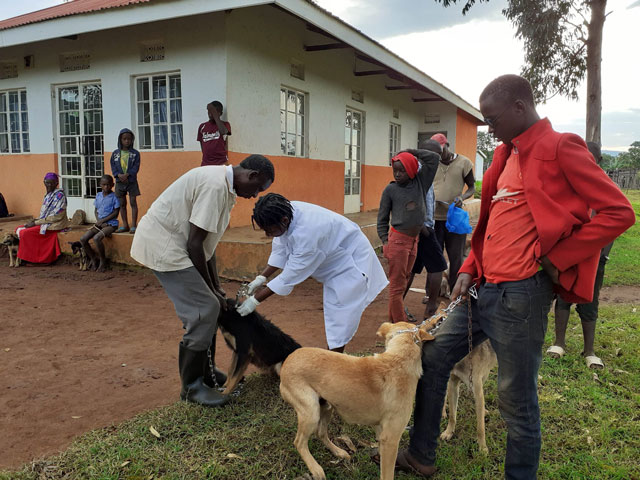
COMMENT | By Dr. Isabel Mweheire | Veterinary doctors, also known as Veterinarians or Veterinary surgeons are trained to detect, diagnose, treat, prevent and control diseases in animals. In so doing, they have a duty to prevent the human population from acquiring some diseases that can come from animals. There are many diseases that humans can acquire from animals as a result of the interaction of humans and animals or animal products like meat, milk, eggs, skins, hides and wool. Many of these diseases can exhibit severe sickness that is difficult to treat and most of them lead to death.
In this article, as Uganda joins the rest of the world in Rakai to mark World Veterinary Day, I will briefly discuss at least seven diseases or groups of diseases that are essentially diseases of animals but commonly jump into the human population. The role of the Veterinary doctor in preventing these diseases in humans will also be elucidated.
Rabies: Rabies is a viral disease of the nervous system that is spread to humans mainly through the bite of an rabid dog. It affects all mammals, so humans can get it from any other infected animal including cattle, goats, sheep and pigs. As in animals, death is 100% certain in humans once clinical signs appear. Vaccination of dogs is essential for the prevention of rabies in the human population. Veterinary doctors and paravets have to work tooth and nail to vaccinate as many dogs as possible. The more dogs are vaccinated in commmunity, the less incidences of human infections in that community. There is also a vaccine for people at high risk of getting rabies disease.
Brucellosis: Brucellosis is a tricky bacterial infection. It affects cattle, goats, sheep and pigs in which it causes infertility and abortions. However, the bacteria is different in each of those species. The disease that affects humans comes from either cattle or goats. These discharge large quantities of the bacteria during abortions (miscarriages in animals). So humans who get in touch with cattle or goats’ after births, aborted fetuses or fluids will contract the infection. It is so dangerous it can enter through intact skin, or mucous membranes (eyes, ears, nose or mouth). It is therefore advisable to use glovded hands when handling animals which may be having abortions. Brucellosis can also be ingested in raw or half boiled milk, or raw meat that is not properly cooked or roasted. Once infected it is extremely difficult to treat in humans and it can keep re-occuring even after series of treatment regimes.
Veterinarians have to vaccinate cattle and goats to prevent the disease in animals, screen animals for brucellosis by testing blood samples, cull those that test positive, and advise on proper handling of animals which abort in order to prevent the disease jumping to human beings.
Trypanosomiasis: Also known as African sleeping sickness or nagana in humans, is caused by a blood parasite that is transmitted from animal to animal or from animal to humans by an infected tsetsefly. Sleeping sickness is 100% fatal in humans if left untreated. Due to the hard work of Veterinarians, it is no longer as common as it used to be in the 1990s. However, it is still prevalent in cattle.
Veterinarians role is to treat, prevent or control Trypanosomiasis in cattle so that the vector, if present does not carry the disease to people. They also trap and kill the vectors in places where they exist. In Uganda, Veterinary doctors from the ministry af agriculture and other stakeholders like Makerere university have continually researched and developed strategies to eliminate the tsetsefly in Uganda in woodland areas where the disease persists. Due to this work, Uganda reports less than 100 human cases of African sleeping sickness annually.
Tuberculosis (TB) is a bacterial infection, common in hospitals especially in AIDS patients. However, there is a type of TB that is found in cattle and affects people as well. It is one of the types of TB that is really hard to treat in humans. Humans acquire it when they consume meat from an infected animal. While the animal may not clinically show sickness from this disease, humans will be very ill and it can lead to death. Veterinary doctors test cattle and cull positive cases. However, the more important role of the Vet is at meat inspection. When an animal is slaughtered for meat, a Veterinary doctor inspects the meat and can condemn any carcass suspected to have TB. Condemned meat is not allowed to enter the food chain. In so doing, transmission to humans is halted at meat inspection.
Viral Hemorrhagic fevers: Ebola, Marburg, Rift Valley Fever and Congo Cremean Hemorrhagic fever (CCHF) are some of most dreaded diseases in the world, with a death rate above 90% of victims even with the best hospital care. All of the above fevers can spread from animals to humans. Ebola and Marburg are transmitted to humans after contact with infected monkeys and other apes, or after contact with their fluids or their meat in areas where they are eaten. Rift Valley Fever is transmitted from cattle, goats, sheep and other ruminants by biting insects like flies and mosquitoes to humans. It also causes abortions in animals and commonly affects farm workers as they tend to assist aborting animals or clean up aborted fetuses and afterbirths. It also normally affects butchermen as they are in direct contact with the raw meat of carcasses from infected animals. Congo Cremean Hemorrhagic fever (CCHF) is spread to humans from mammals by a some species of ticks.
Wildlife Veterinarians are responsible for treating, preventing and controlling Ebolla and Marburg in monkeys. While domestic Veterinarians prevent the Rift Valley Fever and CCHF in our cattle through vaccinations, proper handling of animals during abortions. Veterinarians are at high risk themselves if they do not practice the highest level of biosecurity, hence protecting people from these killer diseases.
Worms: Worms are bloody parasites that can infest any part of your body from the skin to internal organs like the heart, lungs, stomach, intestines, liver and even the brain. People don’t realize how dangerous worms can be in their bodies. There are two types of worms I want to discuss.
The beef tapeworm and the pork tape worm both larva of two different adult tapes worms that can be found in the intestines of human beings. In cattle and pigs, they are found within the muscles (heart, diaphragm and skeletal muscles). When humans eat parts of these infested muscles, they can get the worm, which then develops into adult worms in their intestines.
Humans can also re-infect themselves when they use contaminated hands or eat vegetables contaminated with human feces. The pork tape worm specifically can then migrate to any part of the body including the brain were it causes seizures.
The downside of these in the meat is that the worm larvae are highly resistant to heat. So that meat can be cooked or roasted but they remain alive within the meat. So even people that eat only well cooked meat can get them.
The Veterinary meat inspector is trained to detect the larva of these worms in meat. On inspection, meat that is found to have these larvae is condemned and will not be allowed to enter into the food chain.
*****
 By Dr. Mweheire Isabel
By Dr. Mweheire Isabel
 The Independent Uganda: You get the Truth we Pay the Price
The Independent Uganda: You get the Truth we Pay the Price



